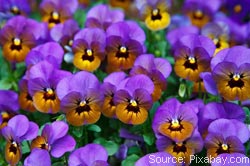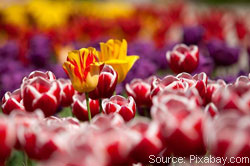 Growing your own garden has many benefits. For starters, it's fun to do and it's also a great way to save money if you grow your own herbs and vegetables to use for cooking. But why should homeowners with backyards and big outdoor gardens have all the fun? Apartment dwellers can also give their green thumbs some exercise by growing an herb or vegetable garden right in their apartment, without the need for all of that luxurious outdoor space.
Growing your own garden has many benefits. For starters, it's fun to do and it's also a great way to save money if you grow your own herbs and vegetables to use for cooking. But why should homeowners with backyards and big outdoor gardens have all the fun? Apartment dwellers can also give their green thumbs some exercise by growing an herb or vegetable garden right in their apartment, without the need for all of that luxurious outdoor space.
Read on to learn more tips and tricks for setting up your own indoor garden in your apartment.
Deciding where to put your garden
Since you live in an apartment and most likely don't have a yard, you don't have very much to work with. Of course, you're going to need to consider several factors when picking out the spot for your indoor garden, such as how much natural light the area receives and how much room is available for your crops to grow. Here are some potential spots to place your garden:
- Balcony or fire escape: The best place to put a garden is outdoors. Since you probably don't have access to a backyard garden area or greenhouse, your next best bet is your balcony or fire escape. If you don't have a balcony or patio and are using your fire escape, make sure you leave enough space to walk if you ever need it to evacuate. Also make sure to receive permission from your landlord or the local fire department. An average sized balcony or patio will be able to fit at least 10 plants comfortably, depending on what you choose to grow.
- Windowsill planters: If a fire escape or balcony isn't a viable option for you, then windowsill boxes should do the job. These containers conveniently hook onto your windowsill and hang outside of your window, receiving all of the sunlight and water that they need, without taking up any space inside your apartment. If you can't hang the planters out of your window, another option is to place them inside the apartment on your windowsill next to a large window that allows a lot of natural sunlight in.
- Roof/courtyard/other outdoor area: Some larger apartment buildings in big cities have roof access for their tenants. The roof is a great place to start a small garden because it's always in the path of direct sunlight and can receive water and nutrients from precipitation. If you don't have roof access, you can check with your landlord to see if you're permitted to place a few containers in the front of the building, along the sides or in the back, if the building has an outdoor courtyard area.
How to get your garden the proper light
Once you've figured out where you want to place your apartment garden, you'll have to determine if that spot receives sufficient sunlight to serve as a suitable place for your vegetables and herbs to grow. The best way to do this is by carefully monitoring the space over the course of a day or two:
- The amount of sunlight you'll need will depend on what you're growing. Different plants and vegetation require different amounts of sunlight each day to grow, so do a little bit of research on the plants you plan on growing and figure out the optimal amount of sunlight needed for each plant to thrive.
- Figure out how much sun your planned garden space receives. You can do this by monitoring the space over the course of several days. Keep track of where the sunlight hits it and record it every few hours to make sure that the area receives a steady amount of sun and isn't obstructed by any neighboring buildings or structures. The amount of sunlight your plants need is broken down into several categories. Full sun is classified as six or more hours of direct sunlight daily, while partial sun is four to five hours of direct sunlight and partial shade is two to four hours of direct sunlight.
 If you are growing indoors, invest in a sunlight lamp. If you can't find a suitable outdoor space for your garden that receives sufficient direct sunlight, keeping your garden indoors is a possibility if you invest in a grow light or sunlight lamp with UV bulbs. You can find these lamps in just about any home improvement or garden store. They can cost anywhere from $50 to 100, depending on the size and strength.
If you are growing indoors, invest in a sunlight lamp. If you can't find a suitable outdoor space for your garden that receives sufficient direct sunlight, keeping your garden indoors is a possibility if you invest in a grow light or sunlight lamp with UV bulbs. You can find these lamps in just about any home improvement or garden store. They can cost anywhere from $50 to 100, depending on the size and strength.
What you should grow
The big question remains: what will you grow in your apartment garden? What you'll be able to grow will largely depend on how much direct sunlight your garden receives during the course of a typical day. Spots that receive partial sun of three or fewer hours of direct sunlight per day may only be able to grow smaller plants and herbs, while gardens with more direct exposure to sunlight can grow larger plants and vegetables. You should also consider growing what you need, like herbs that you frequently use in your recipes, so you can save money.
Some herbs and vegetables suited for apartments are:
- Tomatoes that can grow in hanging baskets (like Garden Pearl or Tumbler)
- Mushrooms
- Beans
- Radishes
- Chives, parsley, basil, thyme, rosemary or any other herbs you cook with
- Potatoes
- Salad greens
Indoor gardening kits
For those who weren't exactly born with a green thumb, there are indoor garden kits available for sale through gardening retailers and many online retailers as well, such as Amazon.com. These kits make it much easier to set up your garden and contain seeds for different herbs and vegetables as well as planters and soil.